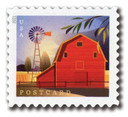
US #5547
2021 Gambrel-Roofed Barn in Summer – Barns (From Pane of 20)
- Showcases the beauty of a gambrel-roofed barn in summer
- Also issued in coil format
Stamp Category: Definitive
Set: Barns
Value: 36¢ Postcard Rate (Nondenominated)
First Day of Issue: January 24, 2021
First Day City: Barnesville, Georgia
Quantity Issued: 100,000,000
Printed by: Banknote Corporation of America
Printing Method: Offset
Format: Panes of 20
Tagging: Phosphor Tagged Paper, Block
Why the stamp was issued: To cover the postcard rate and celebrate the beauty and history of gambrel-roofed barns in the United States.
About the stamp design: Features a digital painting by Kim Johnson of a gambrel-roofed barn in summer.
First Day City: The First Day of Issue postmark was from Barnesville, Georgia. There was no First Day of Issue Ceremony.
About the Barns set: Includes four designs picturing digital paintings by Kim Johnson. Each showcases a different style of barn in a different season. The stamps celebrate the rich history of barns in the United States as well as their visual appeal and cultural significance.
History the stamp represents: In America, when we think of barns, most of us picture what is known as a gambrel-roofed barn. These symmetrical roofs have two slopes on each side, the lower ones at a sharper downward angle (also called a Dutch roof). In the 1848 Dictionary of Americanisms, a gambrel was defined as “A hipped roof of a house, so called from the resemblance to the hind leg of a horse which by farriers is termed the gambrel.”
Gambrel-roofed barns have been around for hundreds of years. The first-known gambrel-roofed building in America was the second Harvard hall at Harvard University. It was built in 1677. Gambrel roofs later became popular for barns because they combined the qualities of a regular sloped roof with increased height. This meant the greater space in the upper level of the barn had a much larger storage area than traditional barns. This space would hold hay, grain, equipment, or anything else the farmer needed.
While many building techniques and designs have been introduced over the years, the gambrel-roofed barn remains popular. When one sees a traditionally painted red and white gambrel-roofed barn, one can’t help but feel a little nostalgic for days gone by. These buildings dot the American countryside and are reminders of the importance of agriculture in our nation’s development.






